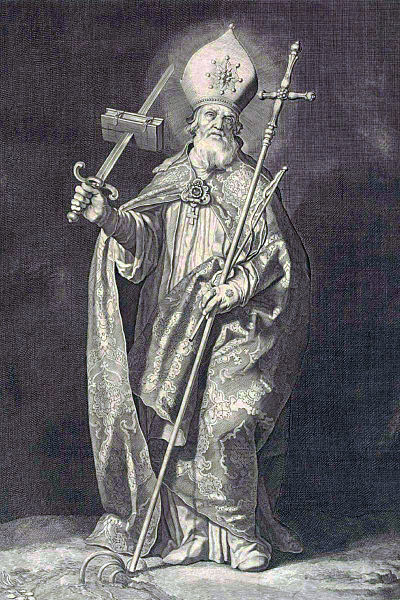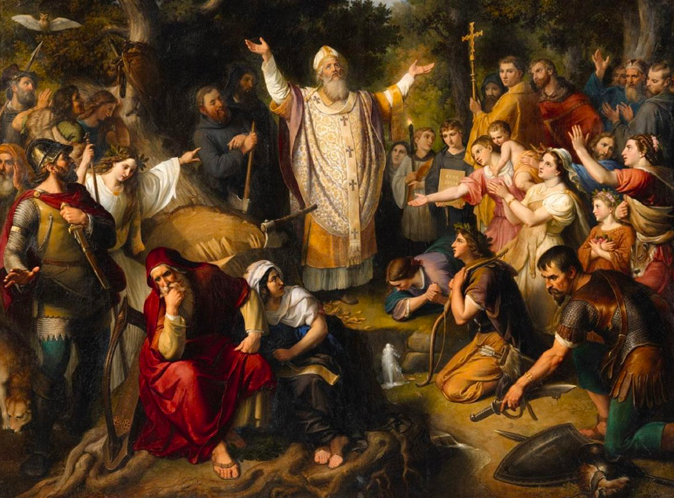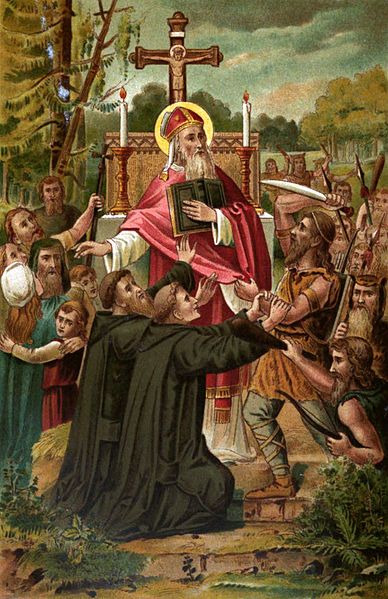The Apostle of Germany

Likely one of the most popular saints of the sanctoral calendar, St. Boniface of Mainz was an eighth-century missionary to Germany. Martyred on June 5, 754, he is still widely celebrated by the Church and remembered as one of the main leaders of the Anglo-Saxon Christian mission to the people of Germania. Although he is often thought of as a symbol of German nationalism, St. Boniface of Mainz was actually not a German himself. Rather, he was originally from Wessex, where he was born around AD 675 and baptized under his given name of Winfrid.
Upon his arrival to the Germanic areas where he worked—modern-day Frisia, Hesse, and Thuringia—it was evident that Boniface had his work cut out for him. In fact, his first mission to Frisia largely failed. Many of the Germans there were deeply devoted to their pagan religions and superstitions. However, over time it was clear that Boniface was an instrument for the Holy Spirit’s work as he found common ground with the Germans and created such long-standing relationships with them that he would be remembered for years after his death.
One of the most compelling stories of this work and his love for the German people comes from the story of his second mission to Hesse, when it is said that the Hessians were so dedicated to the gods of the trees that it was not until Boniface cut down a giant and supposedly sacred oak that many of them came to believe. With that wood Boniface built a chapel and dedicated it to St. Peter, not only converting many Germans to the faith but also forging a strong bond between himself and the congregation he would build there.
Likewise, the Church in Thuringia was in rough shape before Boniface arrived even though it was longer-established than the congregation in Hesse. Even after decades of missions to this region, Christians there were still practicing syncretistic Christian-pagan religions and largely isolated from the rest of Christendom. Yet during Boniface’s time among the Thuringians, he was able to baptize many and establish numerous monasteries and churches that would become important cultural centers for the Church and the Germans’ education and livelihood.
Further, he recruited nuns and monks from the rest of the Church to relocate to modern-day Germany and help build larger and more supportive infrastructures for the Christians there. This would lead to the eventual large-scale conversion of the German people and would lay the foundation for what we see now as a deeply seated Germanic Christian tradition.
Once Boniface had established and revitalized the Church in all of these locations, the pope made him the archbishop of all of Germania in 732. In 754, on his way back to his church in Frisia, Boniface and his troupe (made up of his parishioners) were attacked by an enemy band. Boniface allegedly spoke the words of St. Peter to his party, telling them to “not be overcome by evil, but overcome evil with good” (Romans 12:21) and commanding them to lay down their weapons. They were all martyred.

A Brief History
Boniface has been long heralded by the church as a saint and recognized as one of its most popular martyrs, being remembered as both the “Apostle of Germany” and one of the most famous missionaries of Western Europe. Although his work was primarily for the good of Christianity, many still think of him as not only a man of the Church but also a unifier of Europe, as he worked hard to bring the then-disparate parts of Christendom together into one Body of Christ.
Thus, it makes sense that Boniface has had a prominent place in the Church’s sanctoral calendar for almost the entirety of the sanctoral calendar’s existence, with his day still celebrated by many Christians—Catholics and Protestants alike.
An interesting story that has accompanied Boniface’s martyrdom and has likely contributed significantly to his popularity comes from the possessions rescued from the site where he and his troupe were killed. One of the theological and scriptural books that Boniface carried with him, called the Ragyndrudis Codex, had marks on its cover likely made by a sword or axe. According to eye-witnesses, Boniface tried to protect himself with the book, using the Gospel text as a defense against his murderers. That very same book can still be found today at the church in Fulda, Hesse, where Boniface’s body is buried.

Collect
Grant, we beseech Thee, almighty God: that, celebrating the heavenly birthday of Blessed Boniface, Apostle to the Germans and Thy Martyr, we may, by his example, be emboldened in our faith toward Thee; through Jesus Christ our Lord, who liveth and reigneth with Thee and the Holy Ghost: ever one God, world without end. Amen.
Lessons
Epistle
Gospel
Resources
Issues, Etc. interview with Dr. Matt Phillips on St. Boniface of Mainz
Propers found in Daily Divine Service Book: A Lutheran Daily Missal, edited by the Rev. Heath Curtis
References:
1. Weedon, William. Celebrating the Saints. Concordia Publishing House. 2016.
Images:
1. Saint Boniface, Cornelis Bloemaert, The Netherlands, 1630.
2. Saint Boniface Felling Donar’s Oak, Johann Michael Wittmer, Germany, 1540.
3. Marteldood van den H. Bonifacius, J.A.F. Kronenburg, The Netherlands, 1903.
Some links might be affiliate links which means we may receive a small commission at no extra cost to you. As an Amazon Associate we earn from qualifying purchases.



